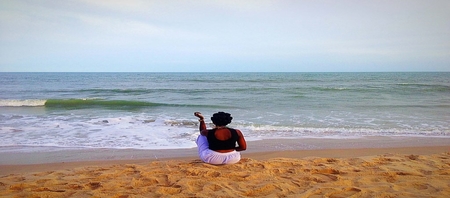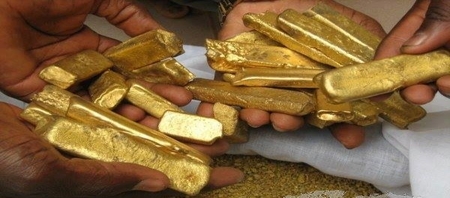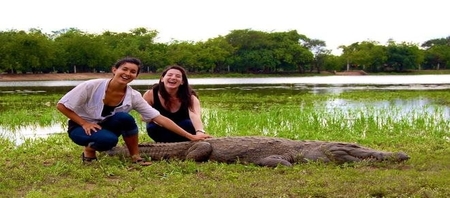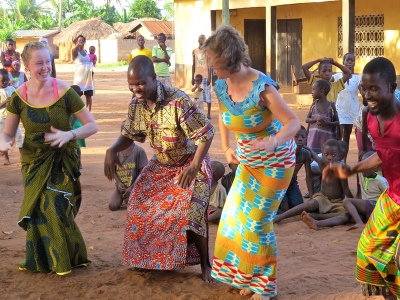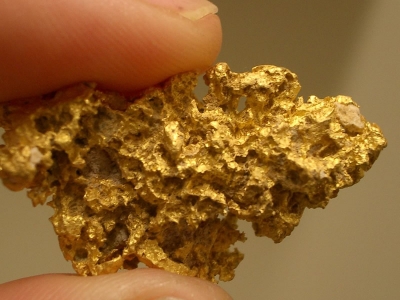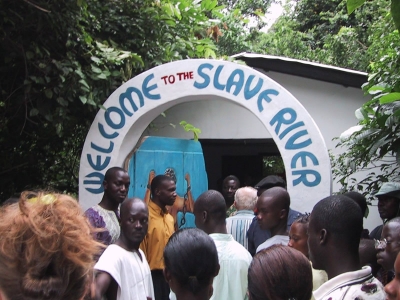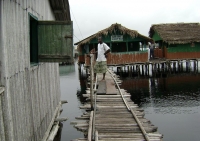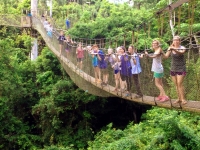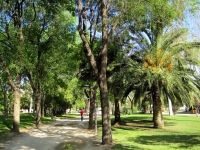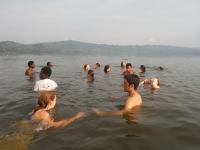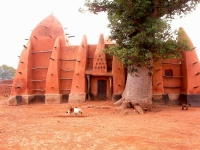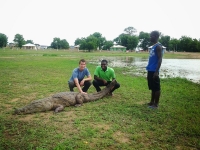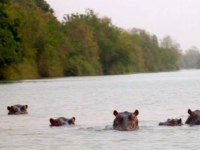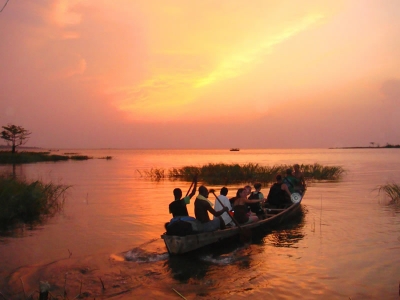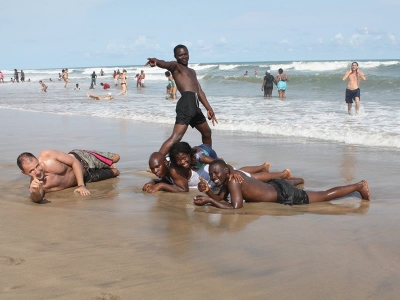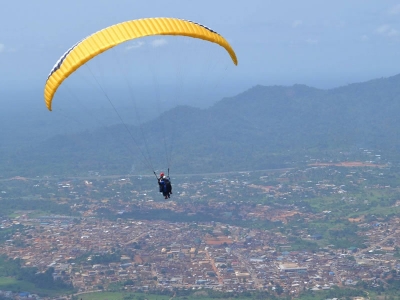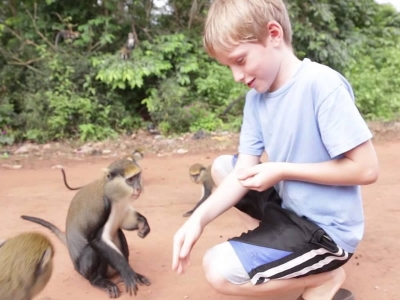Administrator
Western Region
Tuesday, 11 October 2016 13:19One of the natural attractions you don't want to miss when you happen to be in the Western Region of Ghana is the Nzulenzu village.
The whole of this wonderful village sits on stilts and its amazing how the inhabitants of this town have a normal every day life just like people on dry land.
Nzulenzu is located on the north side of the Beyin. Beyin is a transit town for tourists arriving from either Takoradi or Elubo(Ivory Coast border). It is a community of about 500 people living life to the fullest. The entire village is built across a lagoon completely on stilts. The depth of this lagoon depends largely on the season and this can be between 4ft-8ft deep.
You start your journey from Beyin by hiring a canoe which is very cheap and can be shared with other tourists or inhabitants if you're alone. Every canoe has a guide who paddles it and at the same time tell you stories about the origin of the village. nzulenzuIts a jolly ride of about 20-30mins before you arrive at the Nzulenzu village.
The canoe service is organized by the Ghana Wildlife Society and the service runs between 8am-3pm daily, except Thursdays which is observed as a sacred day. wooden buildings in nzulenzuThe wetland around the village has the largest stand of intact swamp forest in Ghana. This is a home to a variety of animals like monkeys. There are also nice species of parrots and exotic birds and this is a nice place for bird lovers if bird watching is your hobby. You see, the whole idea about visiting this village is to see how people survive in different habitats, appreciate nature and be happy wherever you are. Its an eye opener attraction for every body visiting Ghana. So don't be left out.
Central Region
Tuesday, 11 October 2016 13:18Kakum National Park, located in the coastal environs of the Central Region of Ghana, covers an area of 375 square kilometres (145 sq mi). Established in 1931 as a reserve, it was gazetted as a national park only in 1992 after an initial survey of avifauna was conducted. The area is covered with tropical rainforest. The uniqueness of this park lies in the fact that it was established at the initiative of the local people and not by the State Department of wildlife who are responsible for wildlife preservation in Ghana. It is one of only 2 locations in Africa with a canopy walkway, which is 350 metres (1,150 ft) long and connects seven tree tops which provides access to the forest.
The most notable endangered species of fauna in the park are Diana monkey, giant bongo antelope, yellow-backed duiker and African elephant. It is also an Important Bird Area recognized by the Bird Life International with the bird area fully overlapping the park area. The bird inventory confirmed 266 species in the park, including eight species of global conservation concern. One of these species of concern is the white-breasted guineafowl. Nine species of hornbill and the African grey parrot have been recorded. It is very rich in butterflies as well, and a new species was discovered in 1993. As of 2012, the densest population of forest elephants in Ghana is located in Kakum.
The Museums and Monuments Board of the Republic of Ghana has proposed that UNESCO declare the park a natural World Heritage Site under criteria vii and x. The submission made in 2000 is listed under the tentative List of World Heritage Sites.
Greater Accra Region
Tuesday, 11 October 2016 13:09The Presidential Museum (Presidential Museum), also known as Fort Christiansborg or simply the Castle, is a castle located in Osu, Accra, Ghana on the coast of the Atlantic Ocean's Gulf of Guinea. The first substantial fort was built by Denmark-Norway in the 1660s, though the castle has changed hands between Denmark-Norway, Portugal, the Akwamu, Britain, and finally post-Independence Ghana, and was rebuilt numerous times. The castle become the house of government when the capital of Gold Coast (now Ghana) was moved from Cape Coast to Accra in 1877.
For most of the castle's history, it has been the seat of government in Ghana with some interruptions, the latest when the John Kufuor administration moved the seat of government to Golden Jubilee House after 6 January 2009, which was quickly reversed by the incoming John Atta Mills administration. It also serves as the place where the late president of Ghana John Atta Mills was buried, in a bird sanctuary, overlooking the Atlantic Ocean. The castle has now been converted into a presidential museum (museum of heads of state) in commemoration of Ghana's 60th independence day celebrations in 2017.
Eastern Region
Tuesday, 11 October 2016 13:05Aburi Botanical Gardens is a botanical garden in Aburi in Eastern region of South Ghana.
The garden occupies an area of 64.8 hectares. It was opened in March, 1890. Before the garden was established, it was the site of a sanatorium built in 1875 for Gold Coast government officials. During the governorship of William Brandford-Griffith, a Basel missionary supervised clearing of land around the sanatorium to start the Botanic Department.
In 1890 William Crowther, a student from the Royal Botanic Gardens, Kew, was appointed the garden's first curator. The gardens played an important role in encouraging cocoa production in South Ghana, by supplying cheap cocoa seedlings and information about scientific farming methods. After Hevea Brasiliensis was sent to Aburi from Kew in 1893, the gardens also encouraged rubber production in Ghana.
Volta Region
Tuesday, 11 October 2016 13:04Tafi Atome is located in the Volta region not far off the main road from Ho to Hohoe. In 1993 the land around the village of Tafi Atome was set aside as a sanctuary for the Mona Monkey population that lived in the forest that are seen as sacred. When the people of the village first migrated to the area they carried with them their fetish beliefs that revolved around the tortoise and the monkey.
The monkeys are seen as the speakers for the slower quiet tortoise. Because they were sacred they were protected by taboo, and this worked effectively until these beliefs were largely washed out by Christianity. By the 1980s the populations of monkeys were dwindling. After the formation of the sanctuary the populations returned and now they number over 300 and at least 4 different troops. Some are more habituated than others.
This village is definitely worth a visit, beyond the monkeys there is very little hassle in the village and you can take photographs and walk around at ease. After checking into the visitors center you can take a tour of the forest where you will hopefully see the monkeys. Your chances will improve if you bring some bananas, since the monkeys are habituated and already live side by side with the people of the village there is little concern that they will become a nusence so feeding them bananas is ok.
These monkeys differ from the ones at Baobeng Fiema by the white ring of coloring around their waists, they are said to be true monas, and the ones at Baobeng Fiema are and off shoot of the Monas. The ones at Tafi Atome, if you hold your banana firmly in your hand will come and sit on your arm and unwrap the banana and eat it while resting on your arm. These little guys also seemed to have more personality and can seem very playful playing pikaboo and swinging from vines.
In addition the Monkeys as the primary attraction you can take a tour of the village. Take a drum lesson, or even experience a drumming and dancing demonstration in the evenings and some story telling. If you would like to stay in the village as part of the visitors center there is a nice little guest house which by the time you are reading this has hopefully gone through the planned update. There also great opportunities for homestays if you wish. There are bikes for rent that you can use to get around to the nearby Kente weaving village of Tafi Abuipe, or farther to the Avatime hills.




